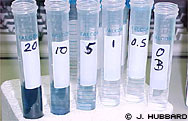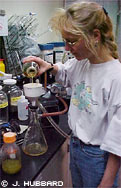In my last journal entry (“Do Macroalgae Rule The World”) I was describing the collection of algae we are working with. Today I am going to tell you a little bit more about what we are doing with them.
As mentioned before, one of our objectives is to see whether macroalgae are chemically defended against predators. As one part of this project, I am looking specifically for defensive chemicals in brown algae. Other than red or green algae, the browns contain chemical compounds called phlorotannins. These are large molecules that occur in similar form as tannins in terrestrial plants and also give this special taste to dark red wines.
Phlorotannins in brown algae from other geographical regions than the Antarctic are known to have a variety of functions. Among others, they can give structural stability to the cells, they can have antimicrobial function, and they can be active in chemical defense against predators. And this is what I am looking for in Antarctic brown algae.
For this, I have first to determine the concentration of phlorotannins in the different algal species, and then I have to determine if they are active as deterrents. Today, I am going to talk about the first part: measurement of the concentration of phlorotannins in brown algae.
After the algae are collected, I take little pieces of tissue out of different parts of the plants, such as the holdfast (which is the “root” of an alga), and different parts of the thallus (which is the “leaf”). I grind these tissue pieces in methanol to break up the cells and get the cell content into the solvent. From this extract I determine the concentration of the phlorotannins with a photometric method, the Folin-Denis-Assay. A photometric method basically means that I expose my samples to a light beam of a certain wavelength and measure how much of this light is absorbed by the extract. That sounds easy enough, but of course it’s a little more complicated.
In order to absorb light at a certain wavelength, the samples must have the right color. Brown algal extracts usually have a brownish-greenish color that derives from the pigments. But I want to measure phlorotannins not pigments, and so I use some chemistry to selectively stain the phlorotannins. I add a whole bunch of chemical solutions to the extract and then let it sit for 30 minutes in the dark. When I check them again, the extracts are colored blue and not brown any more! Of course, there is no magic and alchemy behind this, but the added chemicals react specifically with the phlorotannins in the extract and give the nice blue color. The color is more intense the more concentrated the phlorotannins are in the extract.
And in order to determine the phlorotannin concentration in extracts, we have to make a standard curve as a reference. A standard curve is a series of solutions with known concentrations of phlorotannins, and the light absorbance of these solutions is used as a reference to calculate the concentrations in our samples.
I have run the Folin-Denis-Assay on all nine brown algal species that occur here at Plamer Station and have gotten some interesting results. The concentrations between the different algal species differ, and also the concentrations between the various plant parts within one species differ. We don’t know yet what these results mean, but we still have a few weeks to find out. It’s as exciting as a crime story and I am the detective! And in my next journal entry I will tell a little bit about my detective methods: fish bioassays!





